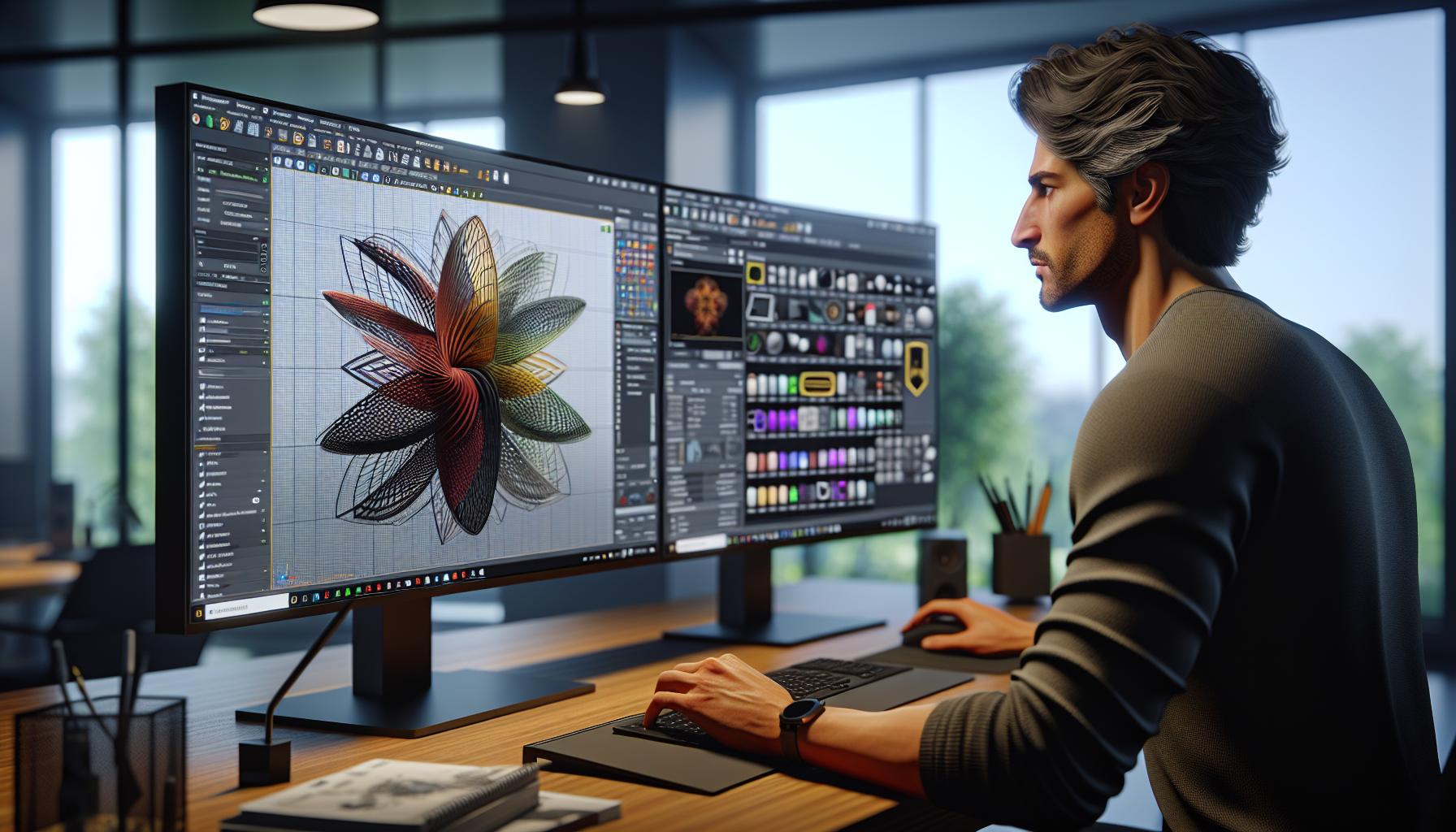In a world where creativity knows no bounds, Adobe’s 3D design software is like a magic wand for artists and designers alike. Imagine transforming your wildest ideas into stunning visual masterpieces with just a few clicks. Whether it’s for a blockbuster film, a jaw-dropping video game, or that quirky art project your friends will never stop talking about, Adobe has got the tools to make it happen.
But wait—before you dive in headfirst, let’s be real. Mastering 3D design can feel like trying to teach a cat to fetch. It’s a challenge, but with Adobe’s intuitive interface and powerful features, you’ll be crafting 3D wonders faster than you can say “rendering.” So buckle up, unleash your inner Picasso, and get ready to explore the exciting world of 3D design that Adobe has to offer.
Adobe 3D Design Software
Adobe’s 3D design software provides powerful tools for artists and designers. Users can create stunning visuals for various applications, such as films, games, and marketing materials. Key features include a user-friendly interface, enhanced modeling capabilities, and a comprehensive library of resources.
Numerous applications fall under Adobe’s 3D design software umbrella. For instance, Adobe Dimension allows users to create high-quality 3D mockups. Users can combine 2D and 3D assets effortlessly. Moreover, Adobe Substance 3D Texturing enables professionals to design complex textures that enhance realism.
Artists appreciate Adobe Aero for its focus on augmented reality. This tool allows creators to craft immersive experiences that blend digital assets with the real world. This aspect serves various industries, from education to marketing.
User support and community engagement are significant benefits of Adobe products. Forums and tutorials offer valuable insights, making it easier for newcomers to learn. Many experienced users share their workflows and techniques, fostering a collaborative environment.
Integration with other Adobe products stands out as a major advantage. Designers can seamlessly transfer files between applications like Photoshop, Illustrator, and After Effects. This interoperability streamlines the creative process and boosts efficiency.
Continual updates ensure the software remains current with industry standards. Regular enhancements bring new features, address usability issues, and improve performance. These updates help users adapt to the ever-evolving landscape of design technology.
Exploring what Adobe’s 3D design software offers can inspire creativity and innovation. Whether for professional projects or personal endeavors, it provides the tools needed to bring ideas to life.
Features and Capabilities

Adobe’s 3D design software offers an array of powerful tools that enhance creativity and streamline the design process.
3D Modeling Tools
The software features advanced 3D modeling tools that empower users to create intricate designs with precision. Users can manipulate shapes and structures easily, allowing for innovative design possibilities. Support for parametric modeling gives artists control over dimensions and proportions. Various geometric shapes and editable meshes serve as a foundation for building complex objects. Collaboration tools facilitate teamwork in design projects, enabling multiple users to work on the same model simultaneously.
Texturing and Materials
Robust texturing tools provide artists with the ability to create realistic surfaces and materials. Users can access an extensive library of textures that support customization, allowing for unique finishes on models. Shader controls enable detailed adjustments, enhancing the visual quality of 3D objects. The software also supports seamless integration with Adobe Substance 3D for creating complex materials. This functionality enables designers to apply intricate textures that transform simple models into eye-catching works of art.
Animation and Rendering
Animation capabilities within the software allow for the creation of dynamic actions and movements. Users can utilize keyframe animation to define motion paths for objects, providing flexibility in storytelling. Real-time rendering options enhance the visual experience, enabling immediate feedback during the design process. Tools for lighting and effects create immersive scenes and lifelike animations. Additionally, collaboration with Adobe Aero allows designers to visualize and present their animations in augmented reality, expanding creative opportunities.
Comparison with Other Software

Adobe’s 3D design software holds a competitive edge in various areas compared to other platforms like Blender and Autodesk. Its user-friendly interface appeals to beginners while offering advanced features for professionals.
Adobe vs. Blender
Adobe’s 3D design software excels in integration with other Adobe products, such as Photoshop and Illustrator, creating a seamless workflow. Blender, while powerful and open-source, can present a steeper learning curve for new users. Support for 3D modeling and animation in Adobe’s suite enables efficient project execution, whereas Blender lacks certain industry-specific resources. Additionally, the Adobe library provides ready-to-use assets that elevate design output quickly. Both platforms feature robust community support, yet Adobe’s extensive tutorials stand out for newcomers.
Adobe vs. Autodesk
Autodesk’s software often targets specialized fields like engineering and architecture. Adobe’s 3D design solution, however, caters more to artists focusing on visual storytelling and creative projects. Real-time rendering in Adobe’s suite allows users to visualize outcomes instantly, giving it an advantage for rapid iterations. Autodesk offers powerful modeling tools, yet its interface may feel less accessible. Collaboration features in Adobe’s software enhance teamwork, while Autodesk may require additional tools for similar functionalities. Each software serves its niche, but Adobe’s versatile applications appeal broadly to a diverse range of designers.
User Experience and Interface

Adobe’s 3D design software prioritizes an intuitive user experience, making complex tasks manageable for artists and designers.
Learning Curve
The software features tutorials and guided workflows that speed up the learning process. New users can find step-by-step instructions tailored to various tasks. Experienced creators benefit from advanced tips and techniques shared in community forums. Visual aids are abundant, simplifying grasping new concepts. Regular updates enhance usability, as Adobe addresses user feedback to refine features. With an emphasis on ease of use, transitioning from traditional design to 3D modeling becomes less daunting. The supportive community encourages user engagement, facilitating knowledge sharing and skill development.
Customization Options
A comprehensive library of resources allows extensive customization of designs. Users can modify textures, materials, and lighting effects to achieve specific aesthetics. Adjustments can be made easily with intuitive sliders and controls that provide instant previews. Importing custom assets ensures that creators can personalize their projects effectively. Integration with other Adobe products further broadens customization capabilities. Collaboration features enable team members to share assets and ideas seamlessly within the interface. This variety supports diverse artistic visions, allowing flexibility in project execution. Overall, Adobe’s software fosters a personalized approach to 3D design.
Pricing and Subscription Models
Adobe’s 3D design software offers flexible pricing options tailored to various user needs. The subscription model includes individual, business, and student plans, ensuring accessibility for everyone from hobbyists to professionals.
Monthly and annual subscriptions provide users with different pricing advantages. A monthly plan costs approximately $54.99, while the annual plan drops to about $52.99 per month when billed upfront. Holding a subscription grants access to the latest features and updates, aligning with industry trends.
Team and enterprise options offer scalability for organizations, with customized pricing based on user count. These plans enhance collaboration through shared assets and tools, streamlining design workflows across departments.
Students and educators benefit from discounted rates, often providing significant savings compared to standard pricing. Current educational pricing typically sits around $19.99 a month, making it affordable for learning and experimentation.
Free trials allow potential users to explore software capabilities before committing financially. A trial lasts seven days, offering a risk-free way to assess whether the tools meet specific design needs.
Ultimately, Adobe prioritizes user flexibility through varied pricing. Subscriptions simplify access to advanced features while encouraging creativity and collaboration in 3D design projects. All pricing information is subject to change, so checking Adobe’s official website ensures the most accurate details.
Adobe’s 3D design software stands out as a transformative tool for artists and designers. With its intuitive interface and robust features it simplifies the complex world of 3D modeling. Users can create stunning visuals while benefiting from extensive resources and community support.
The integration with other Adobe products enhances workflow efficiency making it an appealing choice for both beginners and seasoned professionals. Regular updates ensure the software stays relevant and user-friendly.
By offering flexible pricing plans Adobe makes it accessible to a wide range of users. This commitment to creativity and collaboration empowers designers to push boundaries and explore new artistic avenues in their projects.



